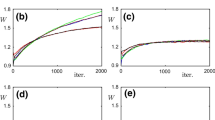Abstract
Networks of spiking neurons are very powerful and versatile models for biological and artificial information processing systems. Especially for modelling pattern analysis tasks in a biologically plausible way that require short response times with high precision they seem to be more appropriate than networks of threshold gates or models that encode analog values in average firing rates. We investigate the question how neurons can learn on the basis of time differences between firing times. In particular, we provide learning rules of the Hebbian type in terms of single spiking events of the pre- and postsynaptic neuron and show that the weights approach some value given by the difference between pre- and postsynaptic firing times with arbitrary high precision.
Similar content being viewed by others
References
M. Abeles, H. Bergman, E. Margalit and E. Vaadia,“Spatiotemporal firing patterns in the frontal cortex of behaving monkeys”, J. of Neurophysiology, Vol. 70, pp. 1629–1638, 1993.
E.K. Blum, “Numerical Analysis and Computation:Theory and Practice”, Addison-Wesley: Reading, MA, 1972.
T.H. Brown and S. Chattarji, “Hebbian synapticplasticity”, in M. Arbib (ed) Handbook of Brain Theory and Neural Networks, pp. 454–459, MIT Press: Cambridge, MA, 1995.
W. Gerstner and L.H. van Hemmen, “How to describe neuronal activity: spikes, rates, or assemblies?”, in Advances in Neural Information Processing Systems 6, pp. 463–470, Morgan Kaufmann: San Mateo, 1994.
W. Maass, “Fast sigmoidal networks via spikingneurons”, Neural Computation, Vol. 9, pp. 279–304, 1997.
W. Maass, “Lower bounds for the computational power of networksof spiking neurons”, Neural Computation, Vol. 8, pp. 1–40, 1996.
W. Maass, “Networks of spiking neurons: the thirdgeneration of neural network models”, Proc. of the 7th Australian Conference on Neural Networks, Canberra, Australia, 1996.
H. Markram, J. Lübke, M. Frotscher and B. Sakmann, “Regulation of synaptic efficacy by coincidence of postsynaptic APs and EPSPs”, Science, Vol. 275, pp. 213–215, 1997.
B. Ruf, “Pattern analysis with networks of spiking neurons” (submitted).
T.J. Sejnowski, “Time for a new neuralcode?”, Nature, Vol. 376, pp. 21–22, 1995.
G.J. Stuart and B. Sakmann, “Active propagation of somatic action potentials into neocortical pyramidal cell dendrites”, Nature, Vol. 367, pp. 69–72, 1994.
S.J. Thorpe and M. Imbert, “Biologicalconstraints on connectionist modelling”, in R. Pfeifer, Z. Schreter, F. Fogelman-Soulié and L. Steels (eds), Connectionism in Perspective, pp. 63–92, Elsevier: Amsterdam, 1989.
Author information
Authors and Affiliations
Rights and permissions
About this article
Cite this article
Ruf, B., Schmitt, M. Learning Temporally Encoded Patterns in Networks of Spiking Neurons. Neural Processing Letters 5, 9–18 (1997). https://doi.org/10.1023/A:1009697008681
Issue Date:
DOI: https://doi.org/10.1023/A:1009697008681




